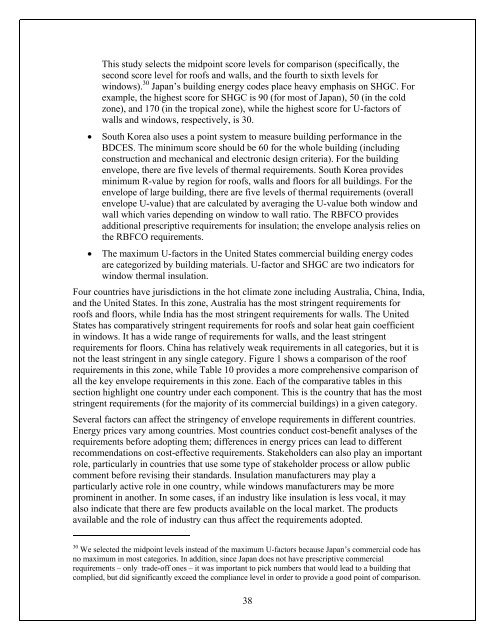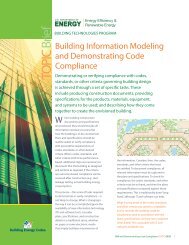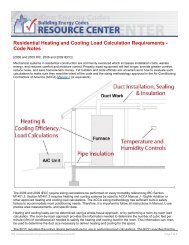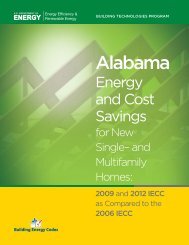Shaping the Energy Efficiency in New Buildings - Building Energy ...
Shaping the Energy Efficiency in New Buildings - Building Energy ...
Shaping the Energy Efficiency in New Buildings - Building Energy ...
You also want an ePaper? Increase the reach of your titles
YUMPU automatically turns print PDFs into web optimized ePapers that Google loves.
This study selects <strong>the</strong> midpo<strong>in</strong>t score levels for comparison (specifically, <strong>the</strong>second score level for roofs and walls, and <strong>the</strong> fourth to sixth levels forw<strong>in</strong>dows). 30 Japan’s build<strong>in</strong>g energy codes place heavy emphasis on SHGC. Forexample, <strong>the</strong> highest score for SHGC is 90 (for most of Japan), 50 (<strong>in</strong> <strong>the</strong> coldzone), and 170 (<strong>in</strong> <strong>the</strong> tropical zone), while <strong>the</strong> highest score for U-factors ofwalls and w<strong>in</strong>dows, respectively, is 30.South Korea also uses a po<strong>in</strong>t system to measure build<strong>in</strong>g performance <strong>in</strong> <strong>the</strong>BDCES. The m<strong>in</strong>imum score should be 60 for <strong>the</strong> whole build<strong>in</strong>g (<strong>in</strong>clud<strong>in</strong>gconstruction and mechanical and electronic design criteria). For <strong>the</strong> build<strong>in</strong>genvelope, <strong>the</strong>re are five levels of <strong>the</strong>rmal requirements. South Korea providesm<strong>in</strong>imum R-value by region for roofs, walls and floors for all build<strong>in</strong>gs. For <strong>the</strong>envelope of large build<strong>in</strong>g, <strong>the</strong>re are five levels of <strong>the</strong>rmal requirements (overallenvelope U-value) that are calculated by averag<strong>in</strong>g <strong>the</strong> U-value both w<strong>in</strong>dow andwall which varies depend<strong>in</strong>g on w<strong>in</strong>dow to wall ratio. The RBFCO providesadditional prescriptive requirements for <strong>in</strong>sulation; <strong>the</strong> envelope analysis relies on<strong>the</strong> RBFCO requirements. The maximum U-factors <strong>in</strong> <strong>the</strong> United States commercial build<strong>in</strong>g energy codesare categorized by build<strong>in</strong>g materials. U-factor and SHGC are two <strong>in</strong>dicators forw<strong>in</strong>dow <strong>the</strong>rmal <strong>in</strong>sulation.Four countries have jurisdictions <strong>in</strong> <strong>the</strong> hot climate zone <strong>in</strong>clud<strong>in</strong>g Australia, Ch<strong>in</strong>a, India,and <strong>the</strong> United States. In this zone, Australia has <strong>the</strong> most str<strong>in</strong>gent requirements forroofs and floors, while India has <strong>the</strong> most str<strong>in</strong>gent requirements for walls. The UnitedStates has comparatively str<strong>in</strong>gent requirements for roofs and solar heat ga<strong>in</strong> coefficient<strong>in</strong> w<strong>in</strong>dows. It has a wide range of requirements for walls, and <strong>the</strong> least str<strong>in</strong>gentrequirements for floors. Ch<strong>in</strong>a has relatively weak requirements <strong>in</strong> all categories, but it isnot <strong>the</strong> least str<strong>in</strong>gent <strong>in</strong> any s<strong>in</strong>gle category. Figure 1 shows a comparison of <strong>the</strong> roofrequirements <strong>in</strong> this zone, while Table 10 provides a more comprehensive comparison ofall <strong>the</strong> key envelope requirements <strong>in</strong> this zone. Each of <strong>the</strong> comparative tables <strong>in</strong> thissection highlight one country under each component. This is <strong>the</strong> country that has <strong>the</strong> moststr<strong>in</strong>gent requirements (for <strong>the</strong> majority of its commercial build<strong>in</strong>gs) <strong>in</strong> a given category.Several factors can affect <strong>the</strong> str<strong>in</strong>gency of envelope requirements <strong>in</strong> different countries.<strong>Energy</strong> prices vary among countries. Most countries conduct cost-benefit analyses of <strong>the</strong>requirements before adopt<strong>in</strong>g <strong>the</strong>m; differences <strong>in</strong> energy prices can lead to differentrecommendations on cost-effective requirements. Stakeholders can also play an importantrole, particularly <strong>in</strong> countries that use some type of stakeholder process or allow publiccomment before revis<strong>in</strong>g <strong>the</strong>ir standards. Insulation manufacturers may play aparticularly active role <strong>in</strong> one country, while w<strong>in</strong>dows manufacturers may be moreprom<strong>in</strong>ent <strong>in</strong> ano<strong>the</strong>r. In some cases, if an <strong>in</strong>dustry like <strong>in</strong>sulation is less vocal, it mayalso <strong>in</strong>dicate that <strong>the</strong>re are few products available on <strong>the</strong> local market. The productsavailable and <strong>the</strong> role of <strong>in</strong>dustry can thus affect <strong>the</strong> requirements adopted.30 We selected <strong>the</strong> midpo<strong>in</strong>t levels <strong>in</strong>stead of <strong>the</strong> maximum U-factors because Japan’s commercial code hasno maximum <strong>in</strong> most categories. In addition, s<strong>in</strong>ce Japan does not have prescriptive commercialrequirements – only trade-off ones – it was important to pick numbers that would lead to a build<strong>in</strong>g thatcomplied, but did significantly exceed <strong>the</strong> compliance level <strong>in</strong> order to provide a good po<strong>in</strong>t of comparison.38
















